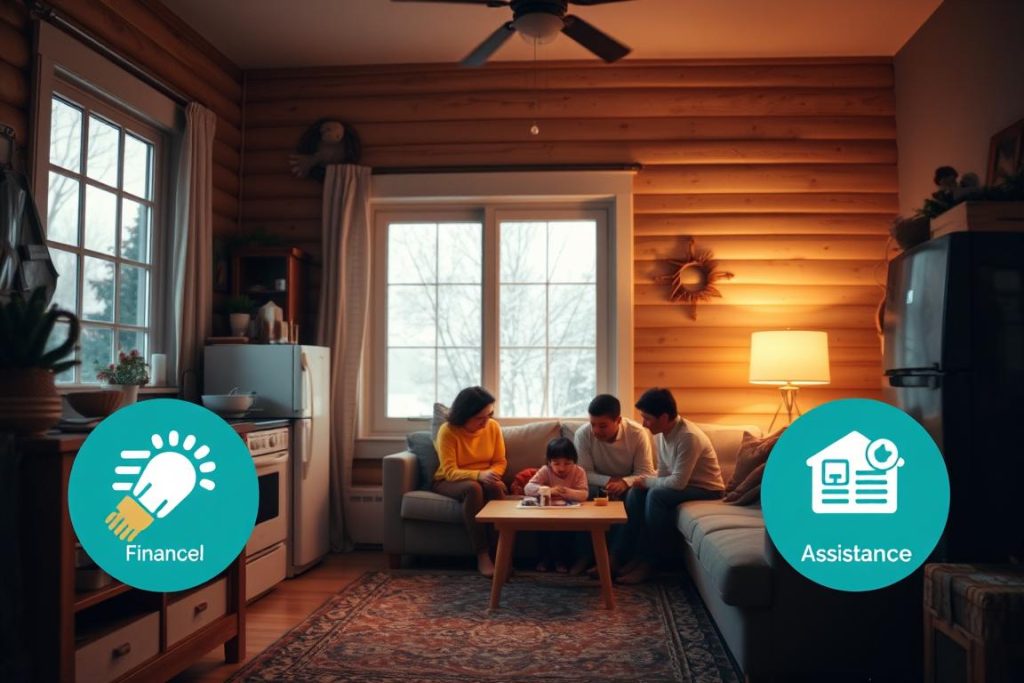As the seasons change, our wallets seem to get thinner with every energy bill. Many households have to choose between paying for utilities or other urgent needs. But the Low Income Home Energy Assistance Program (LIHEAP) offers help. This federal program aims to reduce your utility bills. For 2023, LIHEAP has a budget of $6.1 billion12. It can help cut your energy costs by up to $3,0002.
Imagine getting help with your heating or cooling bills. This support could give you the flexibility to spend money on other essentials. Each year, around 6.7 million households benefit from LIHEAP2. Yet, in 2019, only 16% of those eligible got assistance12. Let’s make sure you get the help you need this year, avoiding the struggle with extreme temperatures.
Key Takeaways
- LIHEAP is a beacon of hope for families juggling high utility expenses.
- You may qualify for up to $3,000 in energy aid, depending on eligibility criteria.
- A significant $6.1 billion has been allocated to LIHEAP for the fiscal year 2023 to support those in need12.
- Preliminary data for 2022 revealed extensive support for heating assistance, totaling approximately $3.398 billion1.
- Take the step towards financial relief by understanding and applying for LIHEAP today.
- If you face an energy crisis, LIHEAP offers fast-tracked assistance within 48 hours for emergencies2.
Understanding LIHEAP: A Comprehensive Guide
The Low-Income Home Energy Assistance Program (LIHEAP) is vital for many Americans struggling to pay energy bills. This program provides financial help, reducing the burden of energy costs. It makes a big difference for those who find it hard to manage these expenses.
What is LIHEAP and How Can It Benefit You?
LIHEAP helps low-income families with their heating and cooling costs. It’s especially helpful for those with high energy needs or living in areas with harsh weather. LIHEAP’s assistance programs ensure people stay comfortable during extreme temperatures. Last fiscal year, it aided 7.1 million households, showing its wide impact3.
Are You Eligible for Federal Energy Assistance?
Many factors affect your eligibility for LIHEAP, like income, household size, and energy costs. To qualify, your income must meet specific requirements. These rules help make sure the aid goes to those most in need. This support can greatly improve life for those facing financial challenges3.
States’ Unique Definitions and Benefits of LIHEAP Crisis Assistance
States can decide what counts as an energy crisis under LIHEAP. It might be a looming utility shutoff or a severe lack of heating. In places like Louisiana, West Virginia, and Massachusetts, many can’t afford their energy bills. This leads to more help and specialized crisis programs3.
Navigating Application Processes for LIHEAP Assistance
The application process for LIHEAP is straightforward. Households can start applying on October 1 each year. This is important for those needing urgent help. It’s wise to reach out to LIHEAP contacts early to secure a place and learn about the benefits in your state. This can greatly lower high utility bill stress.
| State | Percentage of Households Unable to Pay Energy Bills | Max Year-round Benefit Offered |
|---|---|---|
| Louisiana | 31.4% | $6,125 |
| West Virginia | 28.5% | Varies |
| Massachusetts | 27.8% | Based on household needs | New York | Impacted by Potential Funding Cuts | $3,000 expected reduction3 |
Understanding and applying for LIHEAP can change how a family handles extreme weather. It’s important to act quickly to check if you qualify. Applying early ensures you get the help you need. This can greatly increase your comfort and safety at home.
Maximizing Benefits from the Federal Energy Assistance Program
The federal energy assistance program, like LIHEAP, helps you manage your energy bills better. To get the most from LIHEAP benefits, it’s key to apply early. The funds are first-come, first-served, so acting fast is crucial.
LIHEAP has been a big help, giving out $100 billion for bills4. Working with local utilities and other programs makes getting aid smoother5. This teamwork means more people in need get help, building a strong support network.
Getting the most from LIHEAP means knowing what it offers. From 2001 to 2019, only 5% of funds helped with cooling costs4. Check if your state is one of the 21 that provide cooling aid4. This can guide you to the right program, especially in the summer.
In 41 states, LIHEAP makes sure you stay cool in severe heat4. These state-specific programs help avoid power cutoffs during hot spells. They offer financial help and keep your home safe.

Stay in touch with your local LIHEAP office to know about available funds and eligibility changes. Being early in the process brings financial help and improves your energy stability. This is crucial as utility prices rise.
Some states have come up with smart ways to assist people. Like Connecticut, they work with electric companies to quickly find those who qualify for help5. This method speeds up the aid process, helping families stay warm or cool without worry.
To fully use the federal energy assistance program, be proactive and well-informed. Knowing about cooling aids and protective measures can ease the cost burden. The first step to getting these benefits is making the call. Doing so today can secure the help your family needs.
Conclusion
Getting help with energy costs is more than saving money. It’s a sign of hope for many facing high bills. The Low Income Home Energy Assistance Program (LIHEAP) has been this helping hand since 1981.
LIHEAP’s help is more than just assistance—it’s about maintaining respect. It lets you seek aid for energy costs confidently. This program meets different needs, focusing on the elderly, disabled, or families with young children6. LIHEAP makes it easier to keep your home comfortable and safe without the worry of energy bills.
To see how LIHEAP might help you, explore its policies. Doing so will help you understand how to qualify and apply. Knowing these steps ensures help goes to those in dire need, keeping LIHEAP vital7.
FAQ
What is LIHEAP and How Does It Benefit Eligible Households?
What Are the Eligibility Criteria for Federal Energy Assistance Through LIHEAP?
How Do States Define and Provide LIHEAP Crisis Assistance?
What Steps Should I Take to Apply for LIHEAP Assistance?
How Can I Leverage LIHEAP Benefits to Address My Energy Costs?
What Is the Maximum Aid Offered by LIHEAP and Who Receives It?
Can LIHEAP Funding Run Out, and How Should That Affect My Application?
Does Receiving LIHEAP Benefits Affect My Eligibility for Other Federal Programs?
Source Links
- LIHEAP Program – https://link-health.org/liheap-program/
- Struggling with Energy Bills? See How LIHEAP Can Provide Up to $3,000 in Assistance – https://blog.deluxebucks.net/struggling-with-energy-bills-see-how-liheap-can-provide-up-to-3000-in-assistance/
- Need Help Paying Utility Bills? See if You Qualify for LIHEAP – https://www.ncoa.org/article/what-is-the-low-income-home-energy-assistance-program-liheap/
- Utilizing $4bn to Protect Vulnerable Households from Extreme Heat – https://fas.org/publication/liheap-extreme-heat/
- Collaboration with Local Utility Companies & Other Utility Assistance Programs – https://home.treasury.gov/policy-issues/coronavirus/assistance-for-state-local-and-tribal-governments/emergency-rental-assistance-program/promising-practices/utilities
- What is LIHEAP and CEAP Energy Assistance? – Now Power – https://nowpowertexas.com/what-is-liheap-and-ceap-energy-assistance/
- LOW INCOME HOME ENERGY ASSISTANCE ACT OF 1981 – https://adeca.alabama.gov/wp-content/uploads/FY2022-LIHEAP-MANUAL-.pdf

